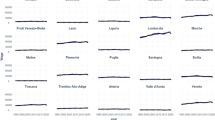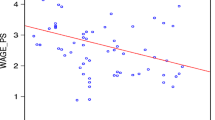Abstract
This paper examines whether changes in the degree of correlation of employment cycles across regions (of Belgium, France, Germany, Ireland, the Netherlands, and Spain) can be explained by changing patterns of specialisation. The empirical method adopted carries out pooled regressions for all possible region-pairs which relate moving correlations between the residuals of HP-filtered regional employment to their own past and an index of specialisation. As a test of robustness, the benchmark estimations which originally include dummies for common borders, German unification and relative differences between regional incomes are systematically tested down. The empirical results again highlight the problem of a common monetary policy for uncommon regions within the euro zone.
Similar content being viewed by others
Abbreviations
- KOR::
-
Bravais, Pearson correlation coefficient measuring the 5-year moving correlation between the residuals of HP-filtered employment of two regions.
- CON::
-
Index of conformity as defined in Table 2.
- SPEC::
-
Finger–Kreinin index as defined in Table 2.
- FIN::
-
Coefficient of specialisation as defined in Table 2.
- RELINC::
-
Relative income for a region-pair, calculated as the absolute value of the difference between the logarithms of real GDP of these two regions. Nominal regional GDP was deflated by the consumer price index of the country the respective regions belong to.
- DUM1::
-
dummy to describe the direct neighbourhood of two regions to each other (1 for common borders, 0 otherwise)
- DUM2::
-
dummy to describe the indirect neighbourhood of two regions to each other (1 for region-pairs separated by exactly one other region, 0 otherwise)
- DUMGER::
-
dummy for German unification coded as 1 for the period from 1990 on, otherwise 0.
Data sources and more detailed specifications of each variable are described in Sect. 3.
References
Amiti M (1997) Specialisation patterns in Europe. Weltwirtschaftliches Archiv 135:573–593
Arellano M (1989) A note on the Anderson–Hsiao estimator for panel data. Econ Lett 31:337–341
Artis MJ, Zhang W (1997) International business cycles and the ERM: is there a European business cycle? Int J Finance Econ 2:1–16
Babetski J, Boone L, Maurel M (2002) Exchange rate regimes and supply shocks asymmetry: the case of the accession countries. CEPR Discussion Paper No. 3408, Centre for Economic Policy Research, London
Barrios S, Brülhart M, Elliott R, Sensier M (2001) A tale of two cycles: co-fluctuations between UK regions and the Euro zone. In: University of Nottingham research paper series No. 02/2001
Baxter M, King RG (1999) Measuring business cycles: approximate band-pass filters for economic time series. Rev Econ Stat 81:575–593
Belke A, Fehn R (2002) Institutions and Structural Unemployment: do capital-market imperfections matter? ifo Studien 48:405–451
Belke A, Gros D (1998) Asymmetric shocks and EMU: is there a need for a stability fund? Interecon Rev Int Trade Develop 33:274–288
Belke A, Gros D (2001) Real impacts of intra-European exchange rate variability: a case for EMU? Open Econ Rev 12:231–264
Belke A, Heine JM (2001) On the endogeneity of an exogenous OCA-criterion: the impact of specialisation on the synchronisation of regional business cycles, HWWA Discussion Paper No. 119, HWWA-Institut für Wirtschaftsforschung Hamburg
Brülhart M (2000) Labour-market effects of intra-industry trade: evidence for the United Kingdom. Weltwirtschaftliches Archiv 138:207–228
Caporale GM, Pittis N, Prodromidis K (1999) Is Europe an optimum currency area? Business cycles in Europe. J Econ Integration 14:169–202
Christodoulakis N, Dimelis SP, Kollintzas T (1995) Comparisons of business cycles in the EC: idiosyncrasies and regularities. Economica 62:1–27
Clark TE, Shin K (2000) The sources of fluctuations within and across countries. In: Hess G, van Wincoop E (eds) Intranational macroeconomics. Cambridge University Press, pp 189–217
Clark TE, van Wincoop E (2001) Borders and business cycles. J Int Econ 55:59–85
Cleveland WS (1993) Visualizing data. Hobart Press
European Central Bank (1999) Monthly Bulletin, July, Frankfurt/Main, pp 35–58
Fatás A (1997) Countries or regions? Lessons from the EMS experience. Eur Econ Rev 41:743–751
Finger JM, Kreinin M (1979) A measure of export similarity’ and its possible uses. Econ J 89:905–912
Forni M, Reichlin L (1997) National policies and local economies: Europe and the United States. In: CEPR Discussion Paper No. 1632, Centre for Economic Policy Research, London
Frankel JA, Rose AK (1998) The endogeneity of the optimum currency area criteria. Econ J 108:1009–1025
Greene WH (2000) Econometric analysis, 4th edn. New Jersey
Greenaway D, Hine RC (1991) Intra-industry specialization, trade expansion and adjustment in the European Economic Space. J Common Market Stud 29:603–622
Higgins M, Zakrajsek E (1999) Purchasing power parity: three stakes through the heart of the unit root null. Federal Reserve Bank of New York, mimeo
Hodrick RJ, Prescott EC (1997) Postwar U.S. Business cycles: an empirical investigation. J Money, Credit Banking 29:1–16
Imbs J (1999) Co-fluctuations. In: CEPR Discussion Paper No. 2267, Centre for Economic Policy Research, London
Inklaar R, DeHaan J (2001) Is there really a European business cycle? Oxford Economic Papers 53:215–220
Kalemli-Ozcan S, Sorensen B, Yosha O (2000) Economic integration, industrial specialisation, and the asymmetry of macroeconomic fluctuations, mimeo
Kim S (1999) Expansion of markets and geographic distribution of economic activities: the trends in US regional manufacturing structure, 1860–1987. Quart J Econ 110:881–908
Krieger-Boden Ch (1999) Nationale und regionale Spezialisierungsmuster im europäischen Integrationsprozess. In: Die Weltwirtschaft No. 2, pp 234–254
Krieger-Boden Ch (2000) Globalization, integration and regional specialisation. Kiel Working Paper, No. 1009
Krugman P (1991) Increasing returns and economic geography. J Polit Econ 99:483–499
Krugman P (1998) What’s new about the new economic geography. Oxford Rev Econ Policy 14:7–17
Krugman P, Venables AJ (1996) Integration, specialisation and adjustment. Eur Econ Rev 40:959–967
Levin A, Lin CF (1992) Unit root tests in panel data: asymptotic and finite-sample properties. University of California, San Diego, Department of Economics Discussion Paper 92–23, May
Midelfart-Knarvik KH, Overman HG, Redding SJ, Venables AJ (2000) The location of European industry. In: CEPR Discussion Paper No. 2618, Centre for Economic Policy Research, London
Molle W (1997) The regional economic structure of the European Union: an analysis of long-run developments. In: Peschel K (ed) Regional growth and regional policy within the framework of European integration. Heidelberg, pp 66–86
OECD (1999) EMU: facts. Challenges and Policies, Paris
Puga D (1999) The rise and fall of regional inequalities. Eur Econ Rev 43:303–334
Puga D (2002) European regional policies in light of recent location theories. J Econ Geogr 2:373–406
Quantitative Micro Software (2000) EViews—command and programming reference. Irvine, California
Ricci LA (1999) Economic geography and comparative advantage: agglomeration versus specialisation. Eur Econ Rev 43:357–377
Schmutzler A (1999) The new economic geography. J Econ Surveys 13:355–379
Venables AJ (1996) Equilibrium locations of vertically linked industries. Int Econ Rev 37:341–359
Wasmer J, Weil P (2000) The macroeconomics of labor and credit market imperfections. In: IZA Discussion Paper No. 179, Bonn
Wifo (1999) Specialisation and (geographic) concentration of European manufacturing, Austrian Institute for Economic Research, Report of a study for the enterprise DG of the European Commission, Brussels
Wooton I, Ludema RD (1999) Regional integration, trade and migration: are demand linkages relevant in Europe? In: Faini R (ed) Migration—the controversies and the evidence, Cambridge, pp 51–68
Author information
Authors and Affiliations
Corresponding authors
Additional information
The authors would like to thank an anonymous referee and the participants in the annual NOEG conference in Innsbruck for helpful comments.
Rights and permissions
About this article
Cite this article
Belke, A., Heine, J. On the endogeneity of an exogenous OCA-criterion: specialisation and the correlation of regional business cycles in Europe. Empirica 34, 15–44 (2007). https://doi.org/10.1007/s10663-006-9017-9
Published:
Issue Date:
DOI: https://doi.org/10.1007/s10663-006-9017-9
Keywords
- Agglomeration
- Specialisation
- Regional Employment
- European Monetary Union
- Regional Business Cycles
- Synchronicity




